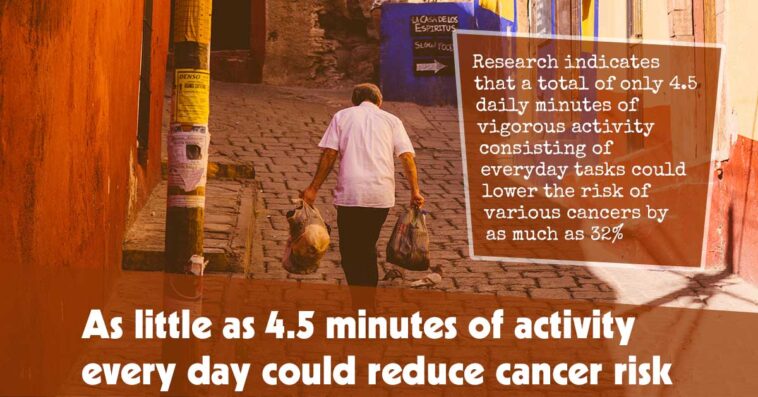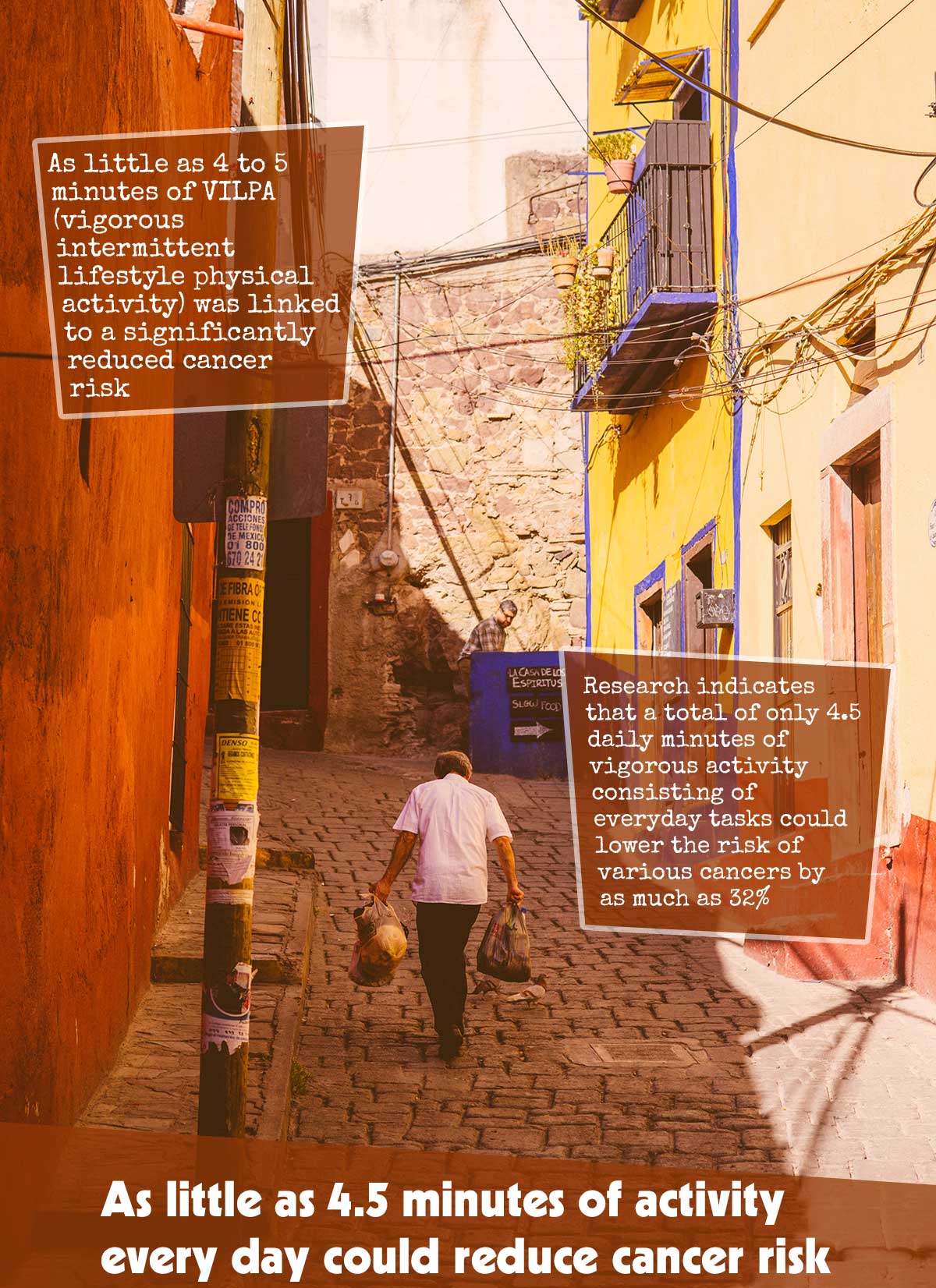Research indicates that a total of only 4.5 daily minutes of vigorous activity consisting of everyday tasks could lower the risk of various cancers by as much as 32%.1✅ JOURNAL REFERENCE
DOI: 10.1001/jamaoncol.2023.1830
The study made use of data taken from wearable devices that tracked the daily activity of over 22,000 individuals who were ‘non-exercisers’. Researchers monitored for cancer by observing the individuals’ health records for about 7 years.
As little as 4 to 5 minutes of VILPA was linked to a significantly reduced cancer risk in comparison to individuals who did not participate in VILPA.
The term VILPA (vigorous intermittent lifestyle physical activity) was created by researchers to identify the very short 1-minute bursts of vigorous activity performed daily. This includes activities such as participating in high-energy games with the children, bursts of power walking, carrying heavy bags of shopping, or vigorous housework. VILPA is a bit like implementing the principles of HIIT into day-to-day life.
Individuals who don’t exercise have an increased risk of some cancers such as colon, endometrial, or breast, but until not too long ago it was not possible to measure the impact of types of vigorous physical activity that are less structured.
We know most middle-aged individuals don’t participate in regular exercise which increases their risk of cancer but it’s only through wearable technology innovation such as activity trackers that it’s possible to evaluate the effect of short bursts of physical activity performed as part of day-to-day living.
It’s encouraging to see that increasing daily task intensity for as little as 4 to 5 minutes a day, performed in short bursts of about 1 minute each, is associated with a general reduction in risk of cancer by as much as 18%, and up to 32% for cancer types related to physical activity.
This is an observational study, which means it isn’t meant to directly examine cause and effect. The researchers however say there is a strong association and refer to prior early-stage studies that show intermittent vigorous physical activity results in rapid cardio-respiratory fitness improvements, which could offer a possible physiologic explanation for a reduced risk of cancer.
Other probable contributing factors include the of role physical activity in improving chronic inflammation and insulin sensitivity.
More studies are required to take a look at this association, but it seems that VILPA could be a potential cost-free recommendation for reducing cancer risk in individuals who find structured exercise unappealing or challenging.
From the study’s 22,398 individuals aged 62 years on average who didn’t participate in leisure time exercise, it was found that:
- There were 2356 new cancer events with 1084 in cancers related to physical activity over a follow-up of 6.7 years on average
- At least about 3.5 minutes of VILPA every day was linked to as much as an 18% reduction in the incidence of cancer in comparison to no VILPA every day.
- 4.5 minutes of VILPA every day was linked to as much as a 32% reduction in the incidence of cancer related to physical activity
- The biggest gains in reduction of cancer risk were observed in individuals who performed small VILPA amounts in comparison to individuals who performed none; benefits however persisted with higher levels of VILPA every day, especially for cancers related to physical activity.
- The majority of VILPA (92 %) happened in bouts of as much as 1 minute.
The current study analyzed the impact of VILPA on total cancer incidence, in addition to 13 cancer sites related to physical activity; such as cancer of the esophagus, breast cancer, bladder cancer, neck and head cancer, colorectal cancer, myeloma, myeloid leukemia, endometrial cancer, gastric cardia cancer, kidney cancer, lung cancer, and liver cancer.
The UK Biobank Accelerometry Sub Study’s data were made use of and only included individuals who identified as ‘non-exercisers’, which means they self-reported not participating in any leisure time exercise or regular recreational walks.
Individuals were excluded who could skew the results such as those with a prior cancer diagnosis or having been diagnosed within a year of enrolling in the study. Other influences which included hereditary cancer risk, diet, sleep, age, cardiovascular disease, BMI, and smoking status were also factored in.
VILPA was evaluated according to the activity levels of the participants as measured by accelerometers worn on the wrist over 7 days at the start of the study. This is in line with other studies involving wearable devices as levels of physical activity remain relatively stable throughout adulthood.
New cancer events were documented utilizing cancer registries, and deaths or hospitalizations as a result of cancer.




